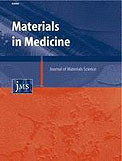Rampichová M, Martinová L, Koštáková E, Filová E, Míčková A, Buzgo M, Michálek J, Přádný M, Nečas A, Lukáš D, Amler E. J Mater Sci Mater Med. 2012 Feb;23(2):555–63. Epub 2012 Jan 6. IF: 2.316

Department of Biophysics
Abstract
The structural properties of microfiber meshes made from poly(2-hydroxyethyl methacrylate) (PHEMA) were found to significantly depend on the chemical composition and subsequent cross-linking and nebulization processes. PHEMA microfibres showed promise as scaffolds for chondrocyte seeding and proliferation. Moreover, the peak liposome adhesion to PHEMA microfiber scaffolds observed in our study resulted in the development of a simple drug anchoring system. Attached foetal bovine serum-loaded liposomes significantly improved both chondrocyte adhesion and proliferation. In conclusion, fibrous scaffolds from PHEMA are promising materials for tissue engineering and, in combination with liposomes, can serve as a simple drug delivery tool.
-mk-
